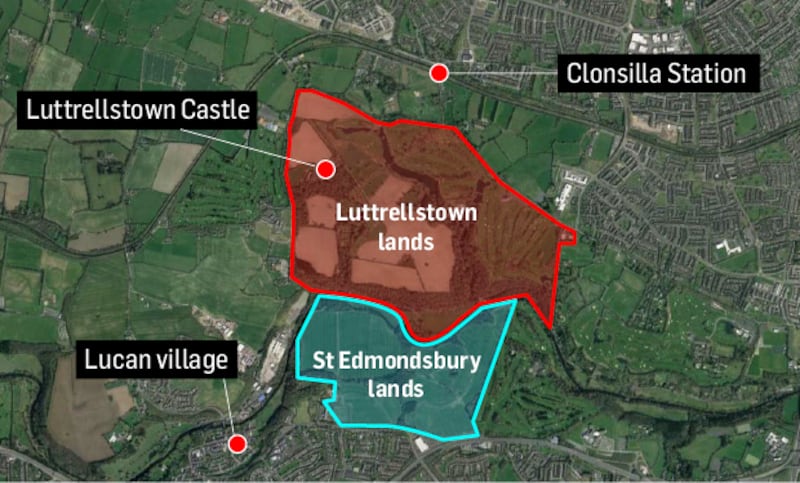It's a steep climb from the banks of the Liffey to Luttrellstown Castle, but it's nothing compared with the uphill struggle tycoons JP McManus and John Magnier face to get their west Dublin riverside lands rezoned for housing.
They, along with Cork property developer Michael O'Flynn, want to build more than 5,000 homes between Lucan and Castleknock, in an area subject to strict environmental and amenity protections.
The land bank of about 348 hectares (860 acres) is divided by the Liffey into two plots, the larger is on the northside surrounding Luttrellstown Castle and golf course, which McManus and Magnier have owned since 2006. Directly south of the river are the St Edmundsbury lands. This smaller plot, about 110 hectares (274 acres) between St Edmundsbury Hospital and the Hermitage golf club, currently used as farmland, was a more recent purchase by the pair, bought in 2013 for a reported sum of just €4.3 million.
The landholding also has the distinction of straddling two local authority boundaries, Fingal County Council north of the river, and South Dublin County Council. Councillors in both jurisdictions on Monday received emails from representatives of the developers emphasising their intention to make good on the Special Area Amenity Order designation on the lands through the development of a Liffey Valley park.
The emails did not mention housing numbers, but said: “The development of the park would, we propose, be accompanied by much needed social, affordable and private housing on lands abutting existing urban development both north and south of the river.”

Amenity designation
In response to queries from The Irish Times the developer's representatives said it was "too early to talk about the location of any new homes in the Liffey Valley area". However, separate documents submitted to each local authority by the developers indicate the bulk will be north of the river with a greater proportion of the southern plot covered by the amenity designation, which aims to protect areas of outstanding natural beauty or recreational value.
In any event, it appears local representatives in either jurisdiction will be reluctant in the extreme to rezone any of these lands for housing.
"I would be extremely sceptical of the current proposal," Fingal Labour councillor John Walsh said. "I would be extremely concerned about the prospect of large-scale residential development in the special amenity area." The submission on behalf of the developers to the council was "wholly inadequate" he said. "It isn't fit for purpose, it doesn't tell us anything of the scale of what is being proposed, but it is essentially asking us to write a blank cheque for large-scale residential development in the Liffey Valley special amenity area."
Fianna Fáil Fingal councillor Howard Mahony said there was already ample land zoned for housing in the area. "There is enough land zoned for housing for 10,000 units in Dublin 15 alone. I would not be supporting any further rezoning for the present development plan."
South Dublin Labour councillor Joanna Tuffy said her council's chief executive had also advised there was sufficient zoned land, and added the council had its own plans for a park. "I think the council should stick with its own objectives for a Liffey Valley park as already set out in the draft development plan and not get distracted by a plan by a developer that would have strings attached in the form of lands being rezoned for housing."
Fine Gael senator Emer Currie, who represents the area, said the strongest protections had been given to the Liffey Valley for a reason. "This is an area of exceptional environmental, recreational and heritage value. We wouldn't be proposing high-density development in the Phoenix Park or Bull Island or the Ring of Kerry."
Housing developments, of significantly lower density, have previously been sought for both sites, but have been rejected largely because of the protection orders on the lands. While there is current pressure to increase residential development, sources in the planning sector said would be hard to argue for the rezoning of these lands when there are sufficient zoned lands not yet developed in the area.












